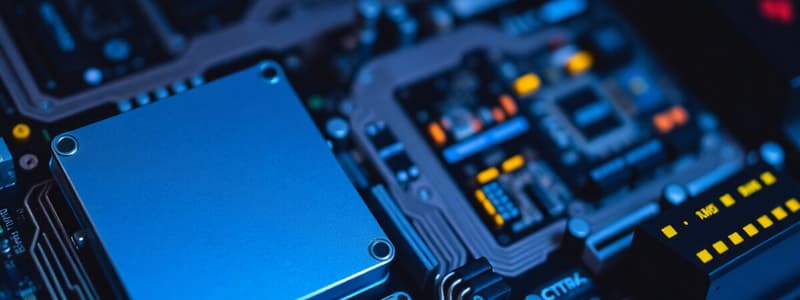Podcast
Questions and Answers
Explain the relationship between data and information within an ICT System. Provide an example to illustrate your explanation.
Explain the relationship between data and information within an ICT System. Provide an example to illustrate your explanation.
Data consists of raw, unorganized facts; information is processed, organized data that provides meaning. For example, a list of student test scores (data) becomes useful information when the average score is calculated.
Differentiate between primary storage and secondary storage in a computer system. What role does each play in processing information?
Differentiate between primary storage and secondary storage in a computer system. What role does each play in processing information?
Primary storage (RAM) is short-term, holding data and instructions currently in use by the CPU for quick access. Secondary storage (like a hard drive) is long-term, storing data persistently. Primary storage allows the CPU to quickly execute instructions and access data, while secondary storage ensures data is saved when the computer is turned off.
Describe the function of the kernel within an operating system. How does it facilitate interaction between software and hardware?
Describe the function of the kernel within an operating system. How does it facilitate interaction between software and hardware?
The kernel is the core of the operating system, permanently held in memory. It manages communication between software and hardware by providing essential services like device management, memory management, and process scheduling.
Compare and contrast application software and utility software, providing an example of each. How do they contribute to the overall functionality of a computer system?
Compare and contrast application software and utility software, providing an example of each. How do they contribute to the overall functionality of a computer system?
Explain the difference between proprietary software and open source software. What are the advantages and disadvantages of each?
Explain the difference between proprietary software and open source software. What are the advantages and disadvantages of each?
Trace the path of a command from an input device, describing how it is processed and eventually displayed on an output device.
Trace the path of a command from an input device, describing how it is processed and eventually displayed on an output device.
How does the role of the CPU differ in a standard desktop computer compared to an embedded computer within a household appliance?
How does the role of the CPU differ in a standard desktop computer compared to an embedded computer within a household appliance?
Explain why a supercomputer is used for weather prediction, while a regular personal computer is not. What characteristics make it suitable for this purpose?
Explain why a supercomputer is used for weather prediction, while a regular personal computer is not. What characteristics make it suitable for this purpose?
Flashcards
Computer
Computer
An electronic device that processes inputs according to instructions to produce outputs.
CPU
CPU
The 'brain' of the computer, executing program instructions.
Primary Storage
Primary Storage
Short-term storage (RAM) for data and instructions currently in use.
Input Devices
Input Devices
Signup and view all the flashcards
Hardware
Hardware
Signup and view all the flashcards
Output Devices
Output Devices
Signup and view all the flashcards
Application Software
Application Software
Signup and view all the flashcards
Data vs Information
Data vs Information
Signup and view all the flashcards
Study Notes
- A computer is an electronic device that takes input, processes it following instructions, and produces output.
- The CPU, or central processing unit, is the computer's "brain," executing program instructions.
- Primary storage (RAM) provides short-term storage for data and instructions actively used by the CPU.
- Input devices, such as keyboards and mice, enable users to enter data and instructions.
- Communication refers to how a computer connects to other devices and networks.
- Hardware comprises the physical, touchable components of a computer.
- Output devices, like displays and printers, present output from the computer to the user.
- The Kernel is the core of the operating system, permanently held in memory.
- Utility software includes programs bundled with the operating system for tasks like backup, compression, and system configuration.
- Application software refers to installed programs that perform specific tasks, such as web browsers and office suites.
- Proprietary software is company-written, requires payment, and restricts user access to its source code, like Microsoft Office.
- Open source software allows users to freely modify and use its source code.
- Advantages of open source software include no cost, source code access, and community support.
- An ICT system is a set of technologies, tools, and processes for creating, storing, sharing, and exchanging information.
- Data consists of raw, unorganized facts, while information is processed, organized data that provides meaning.
- A tablet is a highly portable device, thinner than a laptop because it lacks a mouse or keyboard.
- A server is a powerful computer with specific management capabilities.
- Embedded computers are designed to run household appliances.
- A supercomputer represents the largest type of computer, often used for weather prediction.
Studying That Suits You
Use AI to generate personalized quizzes and flashcards to suit your learning preferences.




